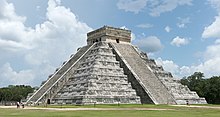Civil engineering is the application of physical and scientific principles for solving the problems of society, and its history is intricately linked to advances in the understanding of physics and mathematics throughout history. Because civil engineering is a broad profession, including several specialized sub-disciplines, its history is linked to knowledge of structures, materials science, geography, geology, soils, hydrology, environmental science, mechanics, project management, and other fields.[6]
Throughout ancient and medieval history most architectural design and construction was carried out by artisans, such as stonemasons and carpenters, rising to the role of master builder. Knowledge was retained in guilds and seldom supplanted by advances. Structures, roads, and infrastructure that existed were repetitive, and increases in scale were incremental.[7]
One of the earliest examples of a scientific approach to physical and mathematical problems applicable to civil engineering is the work of Archimedes in the 3rd century BC, including Archimedes' principle, which underpins our understanding of buoyancy, and practical solutions such as Archimedes' screw. Brahmagupta, an Indian mathematician, used arithmetic in the 7th century AD, based on Hindu-Arabic numerals, for excavation (volume) computations.
Civil engineering profession
See also: History of structural engineering
Engineering has been an aspect of life since the beginnings of human existence. The earliest practice of civil engineering may have commenced between 4000 and 2000 BC in ancient Egypt, the Indus Valley civilization, and Mesopotamia (ancient Iraq) when humans started to abandon a nomadic existence, creating a need for the construction of shelter. During this time, transportation became increasingly important leading to the development of the wheel and sailing.



Education
Main article: Civil engineerCivil engineers typically possess an academic degree in civil engineering. The length of study is three to five years, and the completed degree is designated as a bachelor of technology, or a bachelor of engineering. The curriculum generally includes classes in physics, mathematics, project management, design and specific topics in civil engineering. After taking basic courses in most sub-disciplines of civil engineering, they move on to specialize in one or more sub-disciplines at advanced levels. While an undergraduate degree (BEng/BSc) normally provides successful students with industry-accredited qualification, some academic institutions offer post-graduate degrees (MEng/MSc), which allow students to further specialize in their particular area of interest.[19]

Practicing engineers[edit]
In most countries, a bachelor's degree in engineering represents the first step towards professional certification, and a professional body certifies the degree program. After completing a certified degree program, the engineer must satisfy a range of requirements including work experience and exam requirements before being certified. Once certified, the engineer is designated as a professional engineer (in the United States, Canada and South Africa), a chartered engineer (in most Commonwealth countries), a chartered professional engineer (in Australia and New Zealand), or a European engineer (in most countries of the European Union). There are international agreements between relevant professional bodies to allow engineers to practice across national borders.
The benefits of certification vary depending upon location. For example, in the United States and Canada, "only a licensed professional engineer may prepare, sign and seal, and submit engineering plans and drawings to a public authority for approval, or seal engineering work for public and private clients."[20] This requirement is enforced under provincial law such as the Engineers Act in Quebec.[21] No such legislation has been enacted in other countries including the United Kingdom. In Australia, state licensing of engineers is limited to the state of Queensland. Almost all certifying bodies maintain a code of ethics which all members must abide by.[22]
Engineers must obey contract law in their contractual relationships with other parties. In cases where an engineer's work fails, they may be subject to the law of tort of negligence, and in extreme cases, criminal charges.[23] An engineer's work must also comply with numerous other rules and regulations such as building codes and environmental law.
Sub-disciplines.

Visit: https://civil-engineering-conferences.scifat.com/
Nominate Link: https://x-i.me/pravnom
Member Link: https://x-i.me/civilmem
Get Connected Here:
--------------------------------------
--------------------------------------
youtube.com/channel/UC3bk75P_uoV_D1uFxE9DbZw
instagram.com/leo.lily121/
youtube.com/channel/UC3bk75P_uoV_D1uFxE9DbZw
https://twitter.com/home
Nominate Link: https://x-i.me/pravnom
Member Link: https://x-i.me/civilmem
Get Connected Here:
--------------------------------------
--------------------------------------
youtube.com/channel/UC3bk75P_uoV_D1uFxE9DbZw
instagram.com/leo.lily121/
youtube.com/channel/UC3bk75P_uoV_D1uFxE9DbZw
https://twitter.com/home





No comments:
Post a Comment